Development of an Efficient FRET-Based Ratiometric Uranium Biosensor
Abstract
1. Introduction
2. Materials and Methods
2.1. Chemicals and Stock Solutions
2.2. Construction of Expression Vectors for Biosensors
2.3. Expression and Purification of the Biosensors
2.4. Mass Spectrometry Analyses
2.5. Fluorescence Measurements
2.6. Dissociation Constants Calculations
3. Results
3.1. Characterization of Uranyl-Binding Properties of the CaM Used as a Template for the Biosensor
3.2. Effect of CaM Site 2 Inactivation on FRET
3.3. Insertion of Engineered Uranyl-Binding Sites in the CaM Template of the Biosensor
3.3.1. Effect of ∆2–3 Deletions on the Biosensor Response to Calcium
3.3.2. Effect of ∆2–3 Deletions on the Biosensor Response to Uranyl
3.4. Robustness of the Biosensor
3.5. Improvement of the Biosensor Robustness and Selectivity
4. Discussion
Supplementary Materials
Author Contributions
Funding
Institutional Review Board Statement
Informed Consent Statement
Data Availability Statement
Conflicts of Interest
References
- Taylor, D.M.; Taylor, S.K. Environmental Uranium and Human Health. Rev. Environ. Health 1997, 12, 147–157. [Google Scholar] [CrossRef] [PubMed]
- Brugge, D.; delemos, J.L.; Oldmixon, B. Exposure Pathways and Health Effects Associated with Chemical and Radiological Toxicity of Natural Uranium: A Review. Rev. Environ. Health 2005, 20, 177–193. [Google Scholar] [CrossRef] [PubMed]
- Ansoborlo, E.; Prat, O.; Moisy, P.; Auwer, C.D.; Guilbaud, P.; Carriere, M.; Gouget, B.; Duffield, J.; Doizi, D.; Vercouter, T.; et al. Actinide speciation in relation to biological processes. Biochimie 2006, 88, 1605–1618. [Google Scholar] [CrossRef] [PubMed]
- World Health Organization (WHO). Guidelines for Drinking-Water Quality, 4th Edition, Incorporating the 1st Addendum; World Health Organization: Geneva, Switzerland, 2017. [Google Scholar]
- Prat, O.; Vercouter, T.; Ansoborlo, E.; Fichet, P.; Perret, P.; Kurttio, P.; Salonen, L. Uranium Speciation in Drinking Water from Drilled Wells in Southern Finland and Its Potential Links to Health Effects. Environ. Sci. Technol. 2009, 43, 3941–3946. [Google Scholar] [CrossRef] [PubMed]
- Bhalla, N.; Jolly, P.; Formisano, N.; Estrela, P. Introduction to biosensors. Essays Biochem. 2016, 60, 1–8. [Google Scholar] [CrossRef] [PubMed]
- Goode, J.A.; Rushworth, J.V.H.; Millner, P.A. Biosensor Regeneration: A Review of Common Techniques and Outcomes. Langmuir 2015, 31, 6267–6276. [Google Scholar] [CrossRef]
- Blake, R.C.; Pavlov, A.R.; Khosraviani, M.; Ensley, H.E.; Kiefer, G.E.; Yu, H.; Li, X.; Blake, D.A. Novel Monoclonal Antibodies with Specificity for Chelated Uranium(VI): Isolation and Binding Properties. Bioconjugate Chem. 2004, 15, 1125–1136. [Google Scholar] [CrossRef]
- Reisser-Rubrecht, L.; Torne-Celer, C.; Rénier, W.; Averseng, O.; Plantevin, S.; Quéméneur, E.; Bellanger, L.; Vidaud, C. High-affinity uranyl-specific antibodies suitable for cellular imaging. Chem. Res. Toxicol. 2008, 21, 349–357. [Google Scholar] [CrossRef]
- Averseng, O.; Hagège, A.; Taran, F.; Vidaud, C. Surface Plasmon Resonance for Rapid Screening of Uranyl Affine Proteins. Anal. Chem. 2010, 82, 9797–9802. [Google Scholar] [CrossRef]
- Liu, J.; Brown, A.K.; Meng, X.; Cropek, D.M.; Istok, J.D.; Watson, D.B.; Lu, Y. A catalytic beacon sensor for uranium with parts-per-trillion sensitivity and millionfold selectivity. Proc. Natl. Acad. Sci. USA 2007, 104, 2056–2061. [Google Scholar] [CrossRef]
- Xiang, Y.; Lu, Y. Using personal glucose meters and functional DNA sensors to quantify a variety of analytical targets. Nat. Chem. 2011, 3, 697–703. [Google Scholar] [CrossRef]
- Quesada-Gonzalez, D.; Jairo, G.A.; Blake, R.C.; Blake, D.A.; Merkoci, A. Uranium (VI) detection in groundwater using a gold nanoparticule/paper-based lateral flow device. Sci. Rep. 2018, 8, 16157. [Google Scholar] [CrossRef] [PubMed]
- Moraskie, M.; Roshid, H.O.; O’Connor, G.; Dikici, E.; Zingg, J.-M.; Deo, S.; Daunert, S. Microbial whole-cell biosensors: Current applications, challenges, and future perspectives. Biosens. Bioelectron. 2021, 191, 113359. [Google Scholar] [CrossRef] [PubMed]
- Kannappan, S.; Ramisetty, B.C.M. Engineered Whole-Cell-Based Biosensors: Sensing Environmental Heavy Metal Pollutants in Water—A Review. Appl. Biochem. Biotechnol. 2022, 194, 1814–1840. [Google Scholar] [CrossRef] [PubMed]
- Gui, Q.; Lawson, T.; Shan, S.; Yan, L.; Liu, Y. The Application of Whole Cell-Based Biosensors for Use in Environmental Analysis and in Medical Diagnostics. Sensors 2017, 17, 1623. [Google Scholar] [CrossRef]
- Miller, R.A.; Lee, S.; Fridmanski, E.J.; Barron, E.; Pence, J.; Lieberman, M.; Goodson, H.V. “Scentsor”: A Whole-Cell Yeast Biosensor with an Olfactory Reporter for Low-Cost and Equipment-Free Detection of Pharmaceuticals. ACS Sens. 2020, 5, 3025–3030. [Google Scholar] [CrossRef]
- Hillson, N.J.; Hu, P.; Andersen, G.L.; Shapiro, L. Caulobacter crescentus as a whole-cell uranium biosensor. Appl. Environ. Microbiol. 2007, 73, 7615–7621. [Google Scholar] [CrossRef]
- Park, D.M.; Taffet, M.J. Combinatorial sensor design in Caulobacter crescentus for selective environmental uranium detection. ACS Synth. Biol. 2019, 8, 807–817. [Google Scholar] [CrossRef]
- Zhou, P.; Gu, B. Extraction of oxidized and reduced forms of uranium from contaminated soils: Effects of carbonate concentration and pH. Environ. Sci. Technol. 2005, 39, 4435–4440. [Google Scholar] [CrossRef]
- Pearson, R.G. Hard and Soft Acids and Bases. J. Am. Chem. Soc. 1963, 85, 3533–3539. [Google Scholar] [CrossRef]
- Le Clainche, L.; Vita, C. Selective binding of uranyl cation by a novel calmodulin peptide. Environ. Chem. Lett. 2006, 4, 45–49. [Google Scholar] [CrossRef]
- Pardoux, R.; Sauge-Merle, S.; Lemaire, D.; Delangle, P.; Guilloreau, L.; Adriano, J.-M.; Berthomieu, C. Modulating uranium binding affinity in engineered calmodulin EF-hand peptides: Effect of phosphorylation. PLoS ONE 2012, 7, e41922. [Google Scholar] [CrossRef] [PubMed]
- Sauge-Merle, S.; Brulfert, F.; Pardoux, R.; Solari, P.L.; Lemaire, D.; Safi, S.; Guilbaud, P.; Simoni, E.; Merroun, M.L.; Berthomieu, C. Structural analysis of uranyl complexation by the EF-hand motif of calmodulin: Effect of phosphorylation. Chemistry 2017, 23, 15505–15517. [Google Scholar] [CrossRef] [PubMed]
- Beccia, M.R.; Sauge-Merle, S.; Brémond, N.; Lemaire, D.; Henri, P.; Battesti, C.; Guilbaud, P.; Crouzy, S.; Berthomieu, C. Inter-site cooperativity of Calmodulin N-terminal domain and phosphorylation synergistically improve the affinity and selectivity for uranyl. Biomolecules 2022, 12, 1703. [Google Scholar] [CrossRef]
- Pardoux, R.; Sauge-Merle, S.; Lemaire, D.; Delangle, P.; Guilbaud, P.; Beccia, M.R.; Bremond, N.; Berthomieu, C. New Ura-Nium-Chelating Peptides Derived from EF-Hand Calcium-Binding Motif Useful for Uranium Biodetection and Biodecontamination. Patent WO2014155356 A8, 28 March 2014. [Google Scholar]
- Pardoux, R.; Sauge-Merle, S.; Bremond, N.; Beccia, M.R.; Lemaire, D.; Battesti, C.; Delangle, P.; Solari, P.L.; Guilbaud, P.; Berthomieu, C. Optimized coordination of uranyl in engineered EF-hand loop of calmodulin site 1 provides a subnanomolar affinity for uranyl and a strong uranyl versus calcium selectivity. Inorg. Chem. 2022, 61, 20480–20492. [Google Scholar] [CrossRef]
- Miyawaki, A.; Llopis, J.; Heim, R.; McCaffery, J.M.; Adams, J.A.; Ikura, M.; Tsien, R.Y. Fluorescent indicators for Ca2+ based on green fluorescent proteins and calmodulin. Nature 1997, 388, 882–887. [Google Scholar] [CrossRef]
- Zhang, M.; Tanaka, T.; Ikura, M. Calcium-induced conformational transition revealed by the solution structure of apo calmodulin. Nat. Struct. Biol. 1995, 2, 758–767. [Google Scholar] [CrossRef]
- Zhang, X.; Hu, Y.; Yang, X.; Tang, Y.; Han, S.; Kang, A.; Deng, H.; Chi, Y.; Zhu, D.; Lu, Y. FÖrster resonance energy transfer (FRET)-based biosensors for biological applications. Biosens. Bioelectron. 2019, 138, 111314. [Google Scholar] [CrossRef]
- Frommer, W.B.; Davidson, M.W.; Campbell, R.E. Genetically encoded biosensors based on engineered fluorescent proteins. Chem. Soc. Rev. 2009, 38, 2833–2841. [Google Scholar] [CrossRef]
- Kim, H.; Ju, J.; Lee, H.N.; Chun, H.; Seong, J. Genetically Encoded Biosensors Based on Fluorescent Proteins. Sensors 2021, 21, 795. [Google Scholar] [CrossRef]
- Hessels, A.M.; Maarteen, M. Simple method for proper analysis of FRET sensor titration data and intracellular imaging experiments based on isobestic points. ACS Sens. 2016, 1, 498–502. [Google Scholar] [CrossRef]
- Beccia, M.R.; Sauge-Merle, S.; Lemaire, D.; Brémond, N.; Pardoux, R.; Blangy, S.; Guilbaud, P.; Berthomieu, C. Thermodynamics of Calcium binding to the Calmodulin N-terminal domain to evaluate site-specific affinity constants and cooperativity. J. Biol. Inorg. Chem. 2015, 20, 905–919. [Google Scholar] [CrossRef] [PubMed]
- Jiang, J.; Renshaw, J.C.; Sarsfield, M.J.; Livens, F.R.; Collison, D.; Charnock, J.M.; Eccles, H. Solution chemistry of uranyl ion with iminodiacetate: A combined NMR/EXAFS and potentiometry/calorimetry study. Inorg. Chem. 2003, 42, 1233–1240. [Google Scholar] [CrossRef] [PubMed]
- Craggs, T.D. Green fluorescent protein: Structure, folding and chromophore maturation. Chem. Soc Rev. 2009, 10, 2865–2875. [Google Scholar] [CrossRef] [PubMed]
- Mank, M.; Reiff, D.F.; Heim, N.; Friedrich, M.W.; Borst, A.; Griesbeck, O. A FRET-Based Calcium Biosensor with Fast Signal Kinetics and High Fluorescence Change. Biophys. J. 2006, 90, 1790–1796. [Google Scholar] [CrossRef]
- Liu, S.; He, J.; Jin, H.; Yang, F.; Lu, J.; Yang, J. Enhanced dynamic range in a genetically encoded Ca2+ sensor. Biochem. Biophys. Res. Commun. 2011, 412, 155–159. [Google Scholar] [CrossRef]
- Nagai, T.; Yamada, S.; Tominaga, T.; Ichikawa, M.; Miyawaki, A. Expanded dynamic range of fluorescent indicators for Ca2+ by circularly permuted yellow fluorescent proteins. Proc. Natl. Acad. Sci. USA 2004, 101, 10554–10559. [Google Scholar] [CrossRef]
- Tripathi, S.; Portman, J.J. Inherent flexibility and protein function: The open/closed conformational transition in the N-terminal domain of calmodulin. J. Chem. Phys. 2008, 128, 205104. [Google Scholar] [CrossRef]
- Klevit, R.E.; Dalgarno, D.C.; Levine, B.A.; Williams, R.J. 1H-NMR studies of calmodulin. The nature of the Ca2+-dependent conformational change. Eur. J. Biochem. 1984, 139, 109–114. [Google Scholar] [CrossRef]
- Wachter, R.M.; Remington, S.J. Sensitivity of the yellow variant of green fluorescent protein to halides and nitrate. Curr. Biol. 1999, 9, 628–629. [Google Scholar] [CrossRef]
- Miyawaki, A.; Griesbeck, O.; Heim, R.; Tsien, R.Y. Dynamic and quantitative Ca2+ measurements using improved cameleons. Proc. Natl. Acad. Sci. USA 1999, 96, 2135–2140. [Google Scholar] [CrossRef] [PubMed]
- Griesbeck, O.; Baird, G.S.; Campbell, R.E.; Zacharias, D.A.; Tsien, R.Y. Reducing the environmental sensitivity of yellow fluorescent protein. J. Biol. Chem. 2001, 276, 29188–29194. [Google Scholar] [CrossRef] [PubMed]

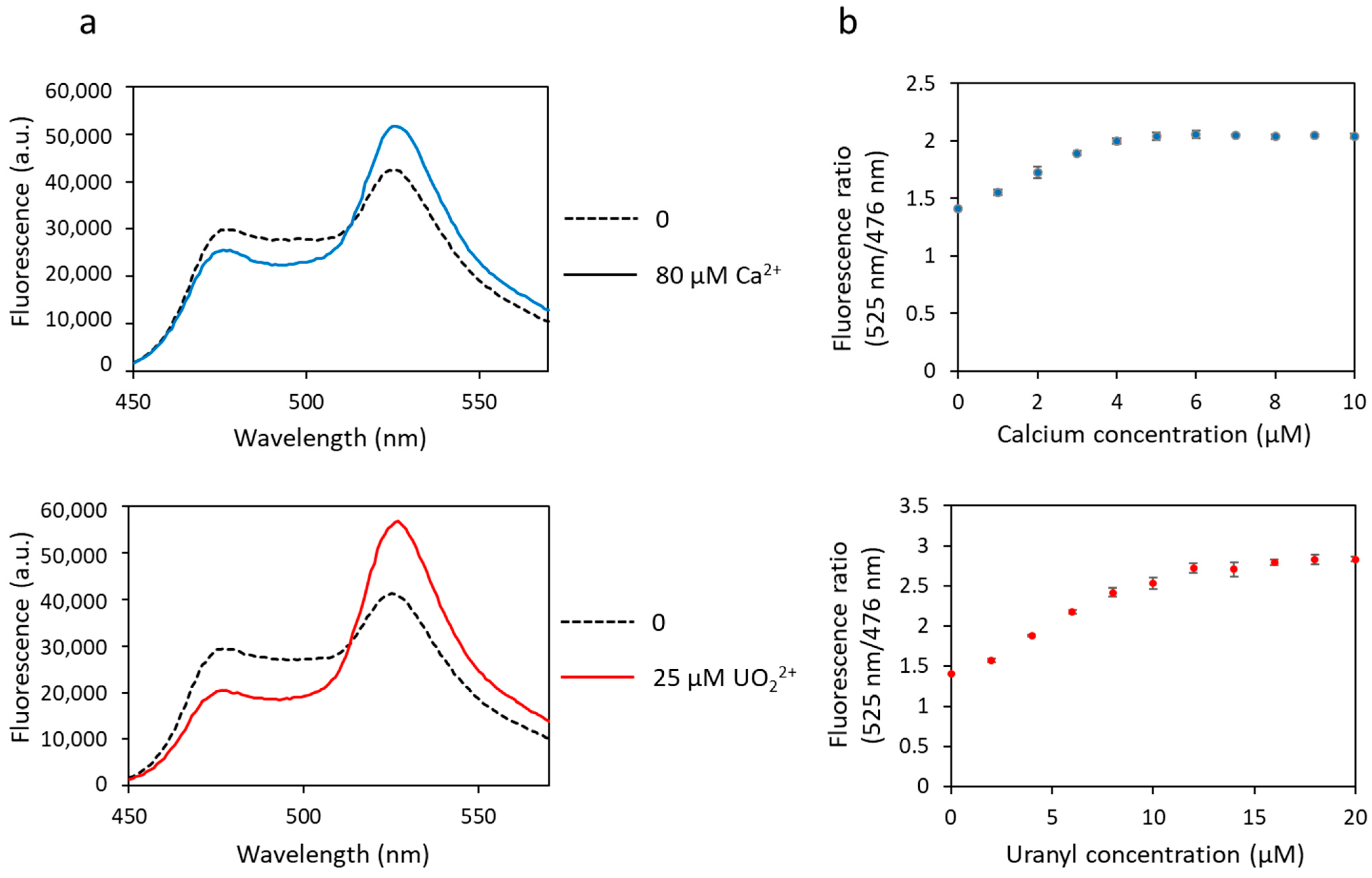
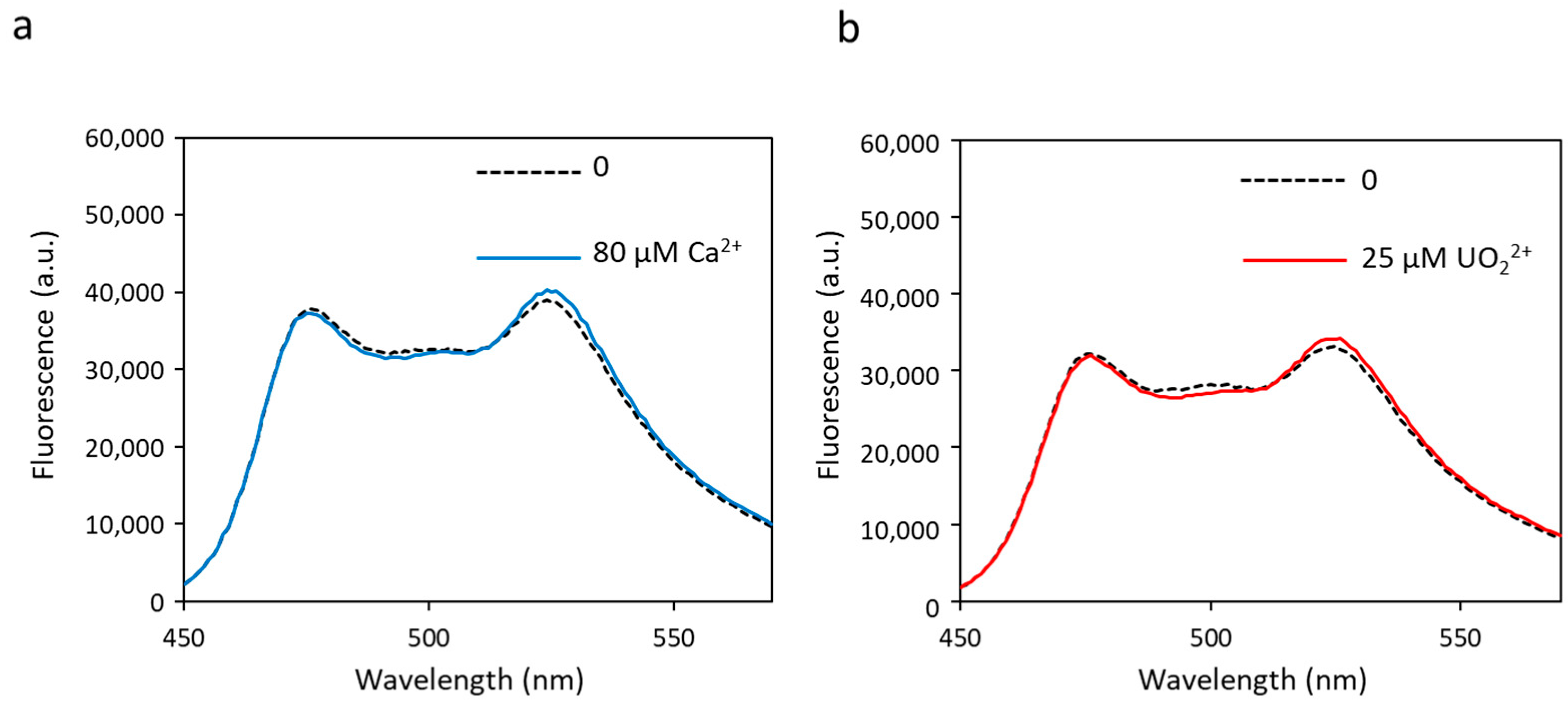
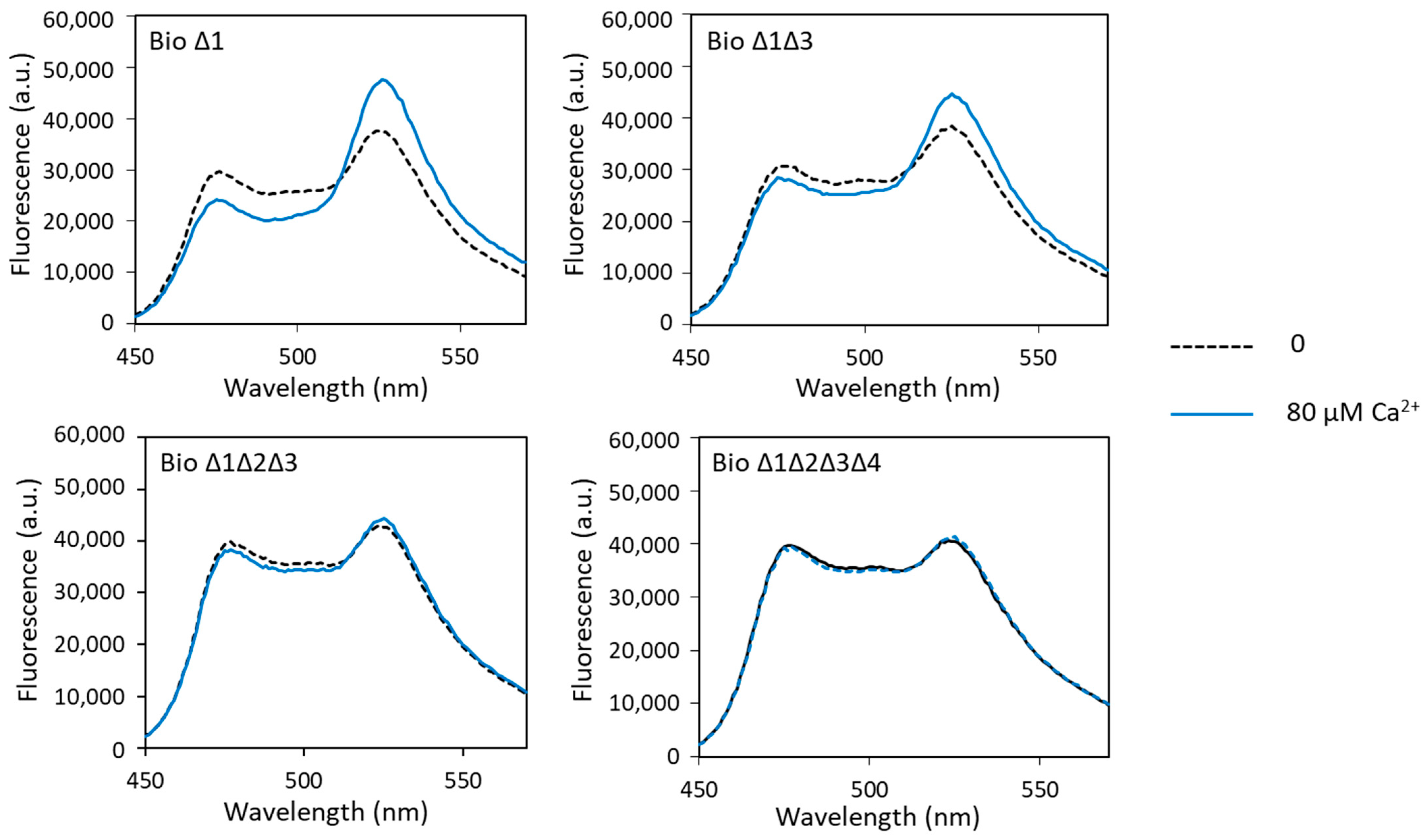
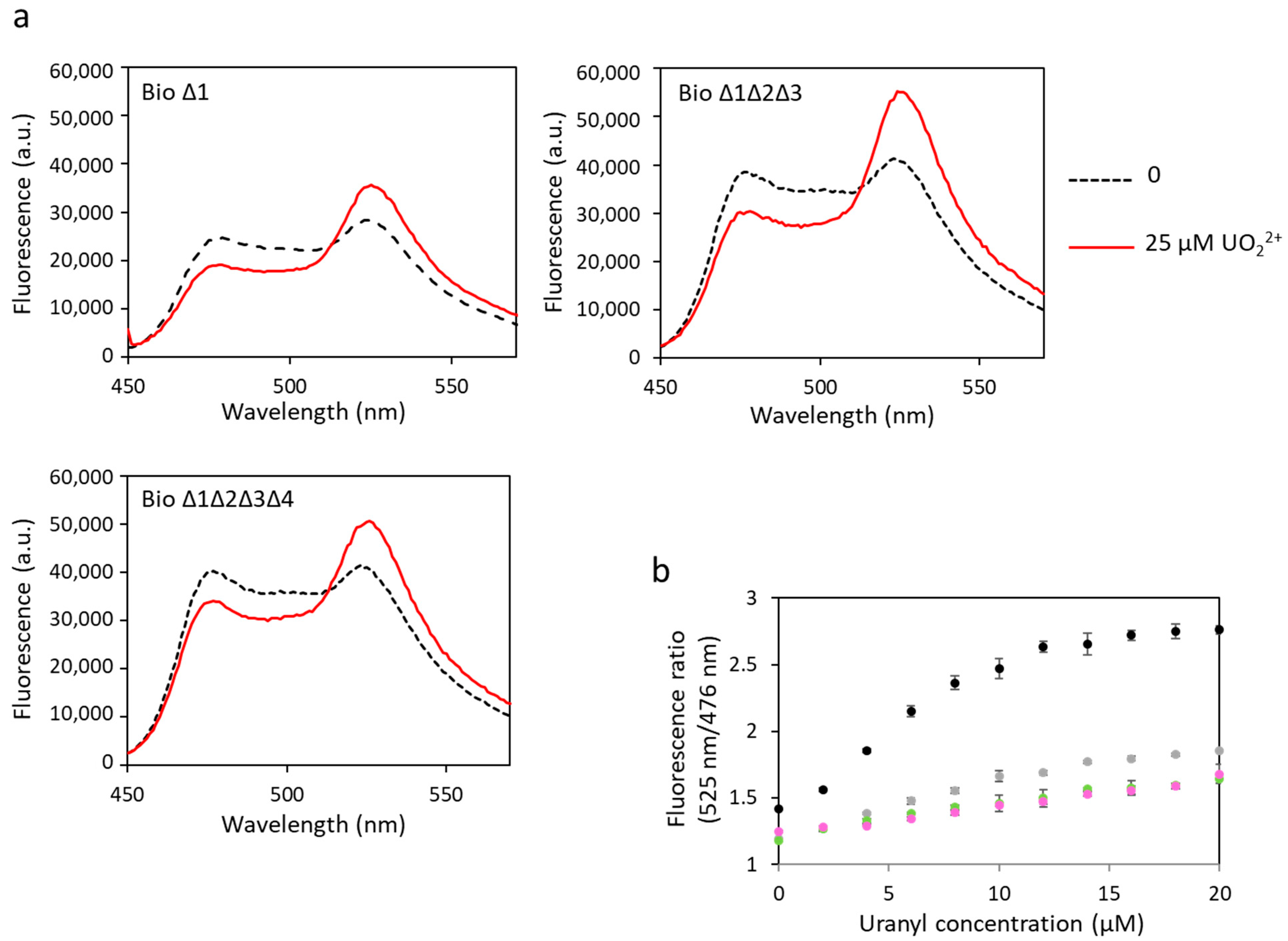


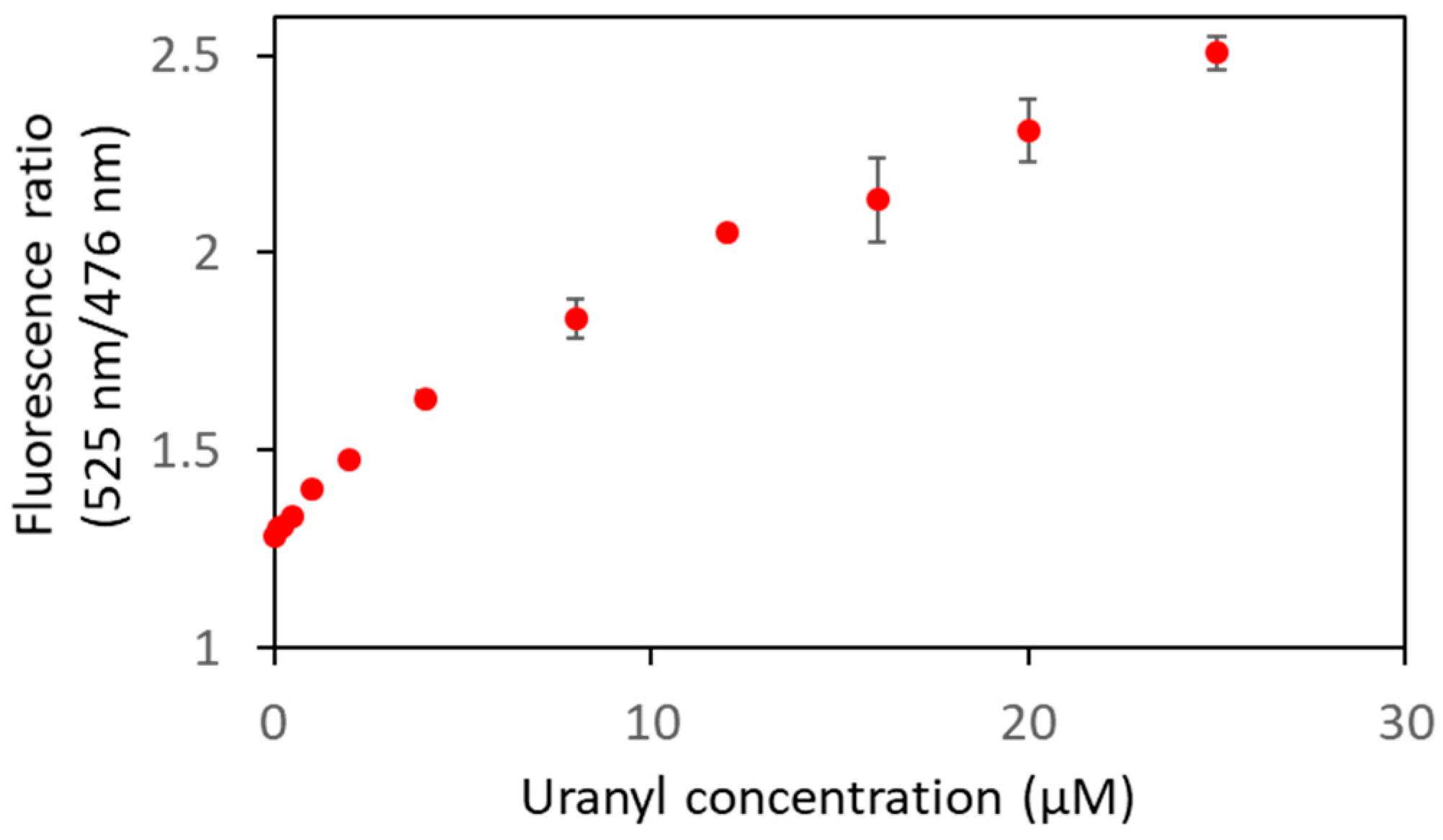
| Protein Name | ∆R/R with Ca2+ | ∆R/R with UO22+ | Kd with Ca2+ | Kd with UO22+ |
|---|---|---|---|---|
| Biosensor 1 | 41% | 95% | 2.4 µM | 14.7 nM |
| Biosensor ∆1 | 49% | 56% | * | * |
| Biosensor ∆1∆3 | 28% | ✕ | * | * |
| Biosensor ∆1∆2∆3 | 4% | 41% | * | * |
| Biosensor ∆1∆2∆3∆4 | 2% | 38% | * | * |
| Biosensor S2I | 2% | 4% | * | * |
| Biosensor ∆1S2I | 0% | 2% | * | * |
| Biosensor Cit | 53% | 82% | 6.1 µM | 14.2 nM |
| Biosensor Cit ∆1∆2∆3∆4 | 6% | 72% | * | * |
| Biosensor Cit ∆1∆2∆3∆4 1 | ✕ | 70% | * | * |
| [Uranyl] in µM | Mean (F525nm/F476nm) | Standard Deviation |
|---|---|---|
| 0 | 1.282 | 0.015 |
| 0.1 | 1.303 | 0.015 |
| 0.2 | 1.308 | 0.011 |
| 0.5 | 1.334 | 0.012 |
| 1 | 1.403 | 0.005 |
| 2 | 1.478 | 0.012 |
| 4 | 1.632 | 0.015 |
| 8 | 1.836 | 0.049 |
| 12 | 2.052 | 0.008 |
| 16 | 2.136 | 0.107 |
| 20 | 2.308 | 0.080 |
| 25 | 2.508 | 0.042 |
Disclaimer/Publisher’s Note: The statements, opinions and data contained in all publications are solely those of the individual author(s) and contributor(s) and not of MDPI and/or the editor(s). MDPI and/or the editor(s) disclaim responsibility for any injury to people or property resulting from any ideas, methods, instructions or products referred to in the content. |
© 2023 by the authors. Licensee MDPI, Basel, Switzerland. This article is an open access article distributed under the terms and conditions of the Creative Commons Attribution (CC BY) license (https://creativecommons.org/licenses/by/4.0/).
Share and Cite
Sauge-Merle, S.; Recuerda, M.; Beccia, M.R.; Lemaire, D.; Cherif, R.; Bremond, N.; Merola, F.; Bousmah, Y.; Berthomieu, C. Development of an Efficient FRET-Based Ratiometric Uranium Biosensor. Biosensors 2023, 13, 561. https://doi.org/10.3390/bios13050561
Sauge-Merle S, Recuerda M, Beccia MR, Lemaire D, Cherif R, Bremond N, Merola F, Bousmah Y, Berthomieu C. Development of an Efficient FRET-Based Ratiometric Uranium Biosensor. Biosensors. 2023; 13(5):561. https://doi.org/10.3390/bios13050561
Chicago/Turabian StyleSauge-Merle, Sandrine, Morgane Recuerda, Maria Rosa Beccia, David Lemaire, Rym Cherif, Nicolas Bremond, Fabienne Merola, Yasmina Bousmah, and Catherine Berthomieu. 2023. "Development of an Efficient FRET-Based Ratiometric Uranium Biosensor" Biosensors 13, no. 5: 561. https://doi.org/10.3390/bios13050561
APA StyleSauge-Merle, S., Recuerda, M., Beccia, M. R., Lemaire, D., Cherif, R., Bremond, N., Merola, F., Bousmah, Y., & Berthomieu, C. (2023). Development of an Efficient FRET-Based Ratiometric Uranium Biosensor. Biosensors, 13(5), 561. https://doi.org/10.3390/bios13050561





